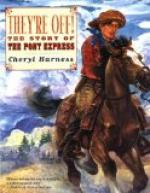[5] Authorities differ somewhat as to the personnel of the first trip; also as to the number of letters carried.
[6] On account of the Mormon outbreak and the troubles of 1857-58, there was at this time much ill-feeling in Congress against Utah. Matters were finally smoothed out and the bill in question was of course dropped. Utah was loyal to the Union throughout the Civil War.
[7] Eastbound the first rider carried about seventy letters.
[8] The idea of a Pony Express was not a new one in 1859. Marco Polo relates that Genghis Khan, ruler of Chinese Tartary had such a courier service about one thousand years ago. This ambitious monarch, it is said, had relay stations twenty-five miles apart, and his riders sometimes covered three hundred miles in twenty-four hours.
About a hundred years back, such a system was in vogue in various countries of Europe.
Early in the nineteenth century before the telegraph was invented, a New York newspaper man named David Hale used a Pony Express system to collect state news. A little later, in 1830, a rival publisher, Richard Haughton, political editor of the New York Journal of Commerce borrowed the same idea. He afterward founded the Boston Atlas, and by making relays of fast horses and taking advantage of the services offered by a few short lines of railroad then operating in Massachusetts, he was enabled to print election returns by nine o’clock on the morning after election.
This idea was improved by James W. Webb, Editor of the New York Courier and Enquirer, a big daily of that time. In 1832, Webb organized an express rider line between New York and Washington. This undertaking gave his paper much valuable prestige.
In 1833, Hale and Hallock of the Journal of Commerce started a rival line that enabled them to publish Washington news within forty-eight hours, thus giving their paper a big “scoop” over all competitors. Papers in Norfolk, Va., two hundred and twenty-nine miles south-east of Washington actually got the news from the capitol out of the New York Journal of Commerce received by the ocean route, sooner than news printed in Washington could be sent to Norfolk by boat directly down the Potomac River.
The California Pony Express of historic fame was imitated on a small scale in 1861 by the Rocky Mountain News of Denver, then, as now, one of the great newspapers of the West. At that time, this enterprising daily owned and published a paper called the Miner’s Record at Tarryall, a mining community some distance out of Denver. The News also had a branch office at Central City, forty-five miles up in the mountains. As soon as information from the War arrived over the California Pony Express and by stage out of old Julesburg from the Missouri River — Denver was not on the Pony Express route — it was hurried to these outlying points by fast horsemen. Thanks to this enterprise, the miners in the heart of the Rockies could get their War news only four days late. — Root and Connelley.




